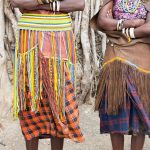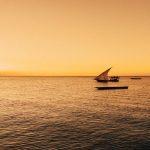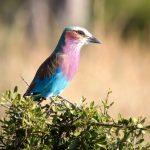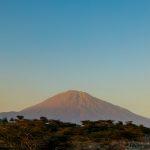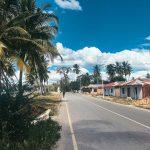The last census in Tanzania estimated the population to be 29,646,753 million, but as the last census was in July 1997, the true figure is probably closer to 40 million today.
This follows an estimated annual population increase of over 3.0% per annum, rising to 4% in Dar es Salaam, with the birth rate at around 46.0 per 1,000 population (1997), and death rate of 15.0 deaths per 1,000. Life expectancy is 49 years, 47 for men, 50 for women. Recent excuses for failing to carry out more up-to-date census included the elections in 2000…but still no census has been carried out.
The majority of the population of Tanzania is primarily of African Bantu origin, numbering around 95 %. Other tribes include Cushitic speakers of Nilotic origins who migrated southwards in previous generations, often as nomadic pastoralists, and a small percentage of descendants of the first hunter-gatherer bushmen tribes who inhabited the land first, undisturbed until around 1,000BC when Cushitic speakers and Bantu tribes moved southwards and westwards to share this region.
The hunter-gatherers are closely associated by physiognomic, cultural and linguistic similarities with the Khoisan (Bushmen) of southern Africa. The Hadzapi and Sandawe tribes represent the only small remaining pockets of these original inhabitants.
The remaining 2% of the population dates from more recent migrations and is made up of Arabic, Asian and European inhabitants. The population of each of these minority groups has dropped dramatically since Independence.
The Linguistic Diversity of Tanzania
As a result of this unusual combination of peoples, The Republic of Tanzania has evolved the greatest linguistic diversity in the whole of the African continent, with four major African language bases, ranging from Bantu, Cushitic and the Nilotic languages to the less comprehensively spoken Khoisan or ‘click’ languages of the bushmen.
Within these broad language groups the different people of Tanzania are of hugely mixed racial origins, with around 129 ethnic groups divided and sub-divided into smaller internal groups. It remains questionable as to how many of these existed before the Western influences of the colonial period categorised them, and the differences between the different ‘tribes’ range between the blatantly obvious to very indistinct.
Of the other three language families, the second most important is the Nilotic group. The Nilotes can be divided into the plains Nilotic or Wa-Maasai, the highland Nilotic, who bear close ancestral similarities with the Wa-Barbaig of north-central Tanzania, and the ‘river-lake’ Nilotic who immigrated from Kenya and Uganda to settle on the eastern shores of Lake Victoria as the Luo tribe.
The Cushitic language has evolved from the Negroid Caucasoid group known as Cushites who have come to Tanzania as the Wa-Mbulu or Iraqw, and these people now farm the fertile volcanic northern highlands on the Great Rift Valley escarpment around Ngorongoro.
It has been one of the founding directives of the Republic that no ethnic group dominates, made easier by the fact that none of the 129 tribes and sub-tribes exceeds much more than 10% of the population.
A governmental drive continues to reduce tribal differentiation to a merely nominal distinction, as chiefdoms are superseded by the boundaries and requirements of national politics. There have been directives to ban tribal clothing and insist that citizens retain a permanent residence.
However, there are still many minority tribal groups still living in rural isolation despite the massive population growth, and they continue to speak their own languages and hold their own internal structures and standards. But the most successful unifying factor in Tanzania is the propagation of Swahili as a national language, enabling a much wider intermingling of all different peoples on the basis of one, fundamentally Bantu, language.
Swahili: a national language for all tribes and all peoples of Tanzania
With such diverse people contained within the boundaries of this great republic, nothing could bring about such a strong sense of nationality and identity as the growth of Swahili as a national language.
The language originates from the coastal regions and Zanzibar, where it developed in response to trade with sailors from the Arabian Gulf, and its name evolved from the Arabic ‘sahil’, meaning coast. It has since evolved to include many distinct examples of vocabulary taken from the most influential foreign visitors and settlers, especially Arabic, Portuguese, German and English, with recognisable words from each of these often reflecting the traces of those cultures left on this African land.
Words such as “chai” (tea), “achari”, (pickle), “serikali” (government), “sheha” (village councillor) are some of the words derived from Persian.
The Portuguese left a legacy of words such as “leso” (handkerchief), “meza” (table), “jela” (prison), “pesa” (money), “mvinyo” (Portuguese ‘vinho’ for wine), etc.
The English words borrowed in Swahili are generally centred around machines or money, with words like “baiskeli” (bicycle), “basi” (bus), “gari” (car), “penseli” (pencil), “mashine” (machine), “kompyuta” (computer), “resiti”, (receipt), etc.
The Germans didn’t teach the Africans their language and hence just a few German words are found in Swahili. Words like “shule” for school.
There are over 100 dialects of Swahili, the purest form being still regarded to come from Zanzibar and the coast, and the language shows great variations in its widespread usage throughout Tanzania and Kenya. Tanzanians tell how coastal people speak most rapidly, and nowadays tend to include more slang expressions in their speech, whereas in rural areas Swahili reflects the local vernacular; the Wa-Sukuma around Lake Victoria employ very emphatic tones, and the Wa-Ha on the shores of Lake Tanganyika speak it slowly and carefully.
The people of Kenya are regarded to be far less polite in their use of Swahili than the Tanzanians, exemplified by their preference of the phrase ‘nataka’, I want, over the more common Tanzanian request, ‘naomba’, I would like.
Closer proximity to other groups of peoples means that many Tanzanians now speak a number of languages and are required to study and converse in only Swahili in school. Bearing in mind that most tribes were originally distinguished on account of their linguistic origins, this indicates a general softening of ‘tribal’ distinctions and reflects the very mixed culture in which many Tanzanians now grow up.
The relatively rapid spread of Christianity and Islam has also had an important bearing on certain tribal beliefs and practices, although these are often held alongside traditional beliefs, with some unusual results. In most cases, distinctive tribal practices are becoming more or less historic, and many individuals will explain their parentage to be of mixed ethnic origin, showing how nowadays intermarrying between tribes is widespread. Nevertheless, almost everyone will be very clearly able to tell you his or her tribal lineage.
The Tribes of Tanzania
The following is not a comprehensive list of all 129 individual tribes, but instead the following information bears reference to the largest or most well known ethnic groups that travellers in Tanzania may encounter, or hear about.
Sukuma
Considerably the largest ethnic group are the Sukuma, who make up 10 – 13% of the population and inhabit the regions around Lake Victoria in Northern Tanzania. The greatness of the tribe has really evolved since all of the small, independent chiefdoms in this region were grouped together and perceived as a unit under the colonial government of Tanzania in 1946.
The Sukuma museum outside Mwanza has gathered together a fascinating collection of memorabilia from the tribal past, including a huge map of the distinct Sukuma regions, and tall ornamental spinning drums showing each of the different forms of counting required, depending on whether you were a boy or girl, shepherd or elder. The centrepiece of the museum is a large pavilion containing vast tribal drums for each chiefdom, and other pavilions show the paraphernalia of historically acclaimed witch doctors and the costumes for traditional dance groups.
The Sukuma traditionally dance with snakes, which they regard as an important spiritual omen, and often keep snakeskins hanging inside their double-walled round huts. Much of their culture is centred around the large, round boulders that dominate the landscape around the shores of Lake Victoria, used by women to grind corn, and by men to peek over the top and spy out the strongest unmarried girl to choose as a wife.
The Haya
The Haya people of the Kagera Region in North West Tanzania are a sizeable tribe, and also show similarities of culture, tradition and language. They are also of Bantu origin, most closely allied with the Bantu to the north and west of them. The Haya were traditionally divided into a series of 130 distinct patrilineal clans, in turn organised into eight small sub-states ruled by a mukama chief. These broad clans included the pastoral Hima people, and the more agricultural Iru.
The Nyamwezi
The Nyamwezi number over 400,000 and mainly inhabit the central regions around Tabora. They rose to great prominence working along the caravan routes, especially during the 19th century, when they challenged even the commercial power of the Arabs with their flare for trade across the interior.
They were among the first tribes to organise themselves into a powerful warrior state, most impressively under the rule of their first warrior chief Mirambo, between 1870 and 1884. They traded mainly in copper, salt, ironmongery and ivory and slaves, and were widely famed for their abilities as long-distance porters.
Their name was given to them by early Swahili traders, and strangely translates as ‘People of the Moon’, probably referring to their habitation of the desolate and vast interior. Their traditional tribal structure developed a greatly revered structure of aristocracy and slaves, and relied rigidly on frequent readings by the mfumi spirit diviner and strict spiritual initiation rites.
The Nyamwezi also bear many cultural and linguistic similarities with the Sukuma people to the North of them.
The Maasai
The widely renowned Maasai tribe are originally Nilotic pastoralists, who migrated into Tanzania along the course of the Nile from southern Sudan. They speak Maa, which bears striking similarities with areas of their origination; maasai in Amharic means ‘like me’, and the Maa word sidan, sounding much like Sudan, means ‘beautiful’ while the word katuum, similar to the Khartoum, the capital of Sudan, means ‘will I get?’.
Certain Maasai tribal factions migrated into Tanzania during the 17th century, having occupied East African lands further north since the 14th century. There remain approximately twelve distinct groups of Maasai around the world, the largest of which now lives in Tanzania.
They call themselves Otunlangana loo Ngishu, meaning The People of the Cattle, and have traditionally made enemies as a result of their fundamental belief the all the cows in the world were rightfully given to them by god.
They have traditionally adhered to very strict social structures and regulations, all in deference to the highest regarded social designation, that of Olaibon, their mediator between the people and the spirits of their ancestors. This is a hereditary title, and the Olaibon is responsible for solving all conflicts within his clan and initiating and closing the tribal age-sets, to which every other Maasai belongs. He is also the tribal healer, and will have the greatest knowledge of plant remedies and medicines upon which the people rely for survival in the bush.
Age sets originate on a seven year scale, mainly concerned with male children and escalating from Engayok, young children remaining at home, to Layooni, attributed to uncircumcised boys who begin to learn the first lessons in herding cattle, to Sikoliyo, the name given newly circumcised boys awaiting their cleansing ceremony which will make him a Maasai Murran, or Morani, a warrior. A boy remains Sikoliyo for up to three months, and during this time he will dress in black robes and adorn his face with patterns of white chalk and soot. He takes an arrow and ventures into the bush, where he must kill birds and use the plumage to adorn his head. After the boy has spent his years as Murran, protecting the rights and safety of the community, he will become Orpaiyan, a married man with children. He is expected to marry numerous wives, and much later becomes an elder, called Ilmoruak, and is responsible for making wise decisions regarding the future of the clan.
The majority of the Maasai remain true to their original beliefs in their traditional religion, based on their god Engai and his messiah, Kindong’oi, from whom their priests descend. Worship is done under ‘holy’ fig trees, or at O’ldoinyo Lengai, which means ‘the mountain of god’. They do not believe in life after death. The Maasai traditionally adhere to a strict diet consisting only of cows milk, blood and meat, and wear a red cloth rubbed with fat for warmth, called shuka.
Such strict tribal regulations have meant that the Maasai have found the conversion to modern living in Tanzania hard, specifically continuing a pastoral nomadic existence in a rapidly more populous country with ever limited space and boundaries. Some Maasai have moved towards cultivation, and many who have had opportunities for education have demonstrated qualities of leadership and decision-making that afforded them positions of great importance within the countries’ universities and government.
The Barbaig
The Barbaig are one of the largest sub-tribes of the broader ethnic group the Datoga. Their language has evolved from Eastern Sudanic roots, and they have a Nilotic appearance that once physically distinguished them from neighbouring tribes such as the WaNyaturu, WyNywamba, the Hadzapi and Sandawe.
The tribe used to practice scarification, marking cuts around each eye and down each cheek with soot from burnt wood, and would pierce and earlobes much like the Maasai. Neither of these practices is considered relevant to their lifestyles today. The Barbaig were close enemies of the Maasai tribe, although their lifestyles were originally remarkably similar, as they also herded (zebu humped) cattle southwards, following the course of the Nile. They continue to share an almost identical practice for making a strong alcoholic drink from aloe roots and wild honey.
The two tribes famously endured a deciding battle over who should inhabit the lush lands of the Ngorongoro Highlands, although the Maasai arrived to find the Barbaig already settled there, and so the Maasai took precedence over the land. But still the tribes regard each other as ‘respected enemies’, and Barbaig elders still return to the graves of their ancestors in Ngorongoro Crater. The Maasai Wars were brought to a halt by the intervention of the German military, and the British administration later put large numbers of the Barbaig on trial.
The Barbaig now live a quieter life, mainly in the region around Mount Hanang, to the West of Tarangire National Park and north of Dodoma. They now combine pastoralism with local cultivation.
Traditional beliefs of the Barbaig
The Barbaig believe strongly in the power of spirits, for good or evil, but also in an afterlife which is a more pleasant and better version of this one, without such destructive enemies as lion, elephant, rhino, cape buffalo, spirits in the form of snakes and invincible alien tribes. The Barbaig, similar to the Maasai, traditionally practice polygamous, often arranged marriages for girls between the ages of 13 and 14, and there were once said to be no unmarried women in the tribe.
The marriage ceremony required the bride to be captured by her suitor in the cow kraal, and the end of her residence in her father’s house was signified by her intended husband placing a string of beads around her neck. The ceremony often did not take place without a struggle, to the extent that she might try to fight away the bridegroom and his helpers with a large stick. As well she might, as her marriage signifies the complete severance of her membership with girls of her age-group, who gather at her home to mourn. After the marriage she is part of her husbands’ wealth, and her children, house and any belongings are his. If they should divorce, she must leave with nothing. After marriage, the women would wear a special pleated leather skirt, known as hananywend, with spiritual-religious significance of Udameselgwa, the female deity and patroness of Barbaig women.
The Sandawe and Hadza/ Hadzapi
The Sandawe and Hadza/ Hadzapi, are distinct tribes but classed together, both being widely held to have the most ancient history of all the tribes, and represent the last remaining ancestors of the first hunter-gatherer tribes.
They speak a language closely related to the ‘click’ language of the southern African Khoisan bushman. The Sandawe occupy an area of northern central Tanzania and are generally more assimilated with surrounding tribes, while the Hadza remain distinct hunter-gatherers, keeping to the rural regions around Lake Eyasi in the North, subsisting on roots and plants, or by bow and arrow during the dry season; their requirements have barely changed from the ancient Palaeolithic Era.
However, the lifestyle of the Hadza is suffering from the encroachment of other populations, whose cattle scatter the game and pollute their water sources, and the growth of conservation areas, such as Ngorongoro, which continue to diminish their hunting grounds. The Hadza have developed a number of ingenious methods of attracting game closer to their arrows, including taking the horns of a slain impala on their heads and bobbing around in the bush imitating the actions of a live one.
This age-old act of impressionism attracts other passing impala straight into the cooking pot. An alternative method is to cover themselves with an animal skin and lie in wait for hungry vultures…as they swoop to land the Hadza hunter can grab the bird in his hand. Remaining still while holding one bird then attracts others, and so the tribe is fed. They supplement their diet with wild honey, a precarious commodity to obtain, but worthwhile for trading with other tribes when supplies of arrowheads or tobacco run dry.
Both the Hadza and the Sandawe have an ancestral tradition of rock paintings, although it is uncertain which group were responsible for the original rock paintings in the Kondoa area between Dodoma and Arusha.
Iraqw (Mbulu)
Also with an extraordinarily ancient history, the Iraqw (Mbulu) who now cultivate the highlands on the escarpment of the Great Rift Valley in Northern Tanzania are linguistically defined on account of their rare Southern Cushitic language.
They are thought to have occupied the lands around Lake Natron, Manyara and Eyasi since ancient times, perhaps since the Upper Palaeolithic period. The Caucasoid origins of the Iraqw indicate that they may have been among the first immigrants to originate food production in East Africa during the 1st millennium, and were probably responsible for the unusually advanced irrigation systems evident in Northern Tanzania, such as those at Engakura.
However, although the civilisation at Engakura could very likely have been initiated by people such as the Iraqw in the 1st millennium, evidence such as later pottery styles found at the site suggest that this settlement achieved much greater significance towards the middle of the 2nd millennium AD.
The Hehe
The Hehe are Bantu-speaking corn and cattle farmers, settled predominately in the southern highlands around Iringa. This diverse and dispersed cluster of patrilineal clans share a similar language and culture, and were among the first to join into a single political state in the mid-19th century under Munyigumba, head of the Muyinga family.
Such organisation was necessary at this time, to protect against groups of the Southern African Ngoni tribe (see below), who were violently raiding all of the southern Tanzanian tribes at this time. When Munyigumba died in 1879, his power of organisation and tribal respect was passed down to his son, Mkwawa, who continued to employ tactics of military organization borrowed from the Ngoni, and continued to expand his people’s domain.
The tribe has been historically renowned for their fierce warrior-like reputation, to the extent that the origins of their name have controversially been attributed to their weird and terrifying battle cry, although some elders also claim that the name has ancestral connections with their place of origin.
The Hehe were subdued by German forces in 1898, but only after seven years of successful, hard-fought resistance, which culminated when the German forces dropped bombs on Mkwawa’s impressively large mud fortress and Mkwawa committed suicide to avoid capture. The paramount tribal chief was restored in 1926, and the heads of the formerly independent peoples were reinstated as sub-chiefs.
Hehe religion has traditionally focused upon the cult of their ancestors, but in recent times many have been converted to Christianity and Islam. Many of the old caravan trade routes passed through their lands, leading towards Kilwa and the coastal regions from the interior, and the Hehe were quick to make the most of business opportunities, finding astute wealth from dealing in ivory, and subsequently they have made the most of opportunities for education and understanding and incorporating western ways.
The Ngoni
The Ngoni are said to have fled from Zululand in south Africa following the force of King Shaka’s Zulu wars, and reached southern Tanzania in 1840, searching for new lands. In around 1845 their main party was broken up at the northern end of Lake Nyasa, and some groups splintered off towards Songea further east, while others continued north to Lake Victoria.
Their strict internal military organisation and consequently successful raiding techniques swiftly encouraged many of the surrounding immigrant tribes to organise themselves into more politically defined leaderships. These southern tribes and the Ngoni stopped fighting among themselves in order to put up a strong and fierce resistance against German occupation.
The Ngoni put up a bloody and hard-fought fight, before they were defeated in 1910.
The Makonde
The Makonde people are also of Bantu origin, and although they continue to live on both sides of the Southern Tanzanian border with Mozambique, they remain one of the five most populous tribes in Tanzania. The Makonde migrated north from Mozambique across the Ruvumi river to the Makonde plateau, now in the region of Mtwara, and this region has taken on a great significance to the tribe, whose traditional creation story tells of a nomadic beginning and leads to settling down on higher ground.
Their legend tells how before human life there lived a being who was neither man nor animal, and it wandered the land alone. One night he began to carve wood from a tree, which he worked into the figure of a female. He left the carving standing upright outside his dwelling while he slept, and the next morning, as the sun dawned on the carving, the female figure came to life. This first beautiful woman became this first being’s wife, and soon the couple conceived and bore a child. But three days after the child was born, it died. The new wife suggested that they should move to higher ground, and when they did she conceived once again. Again a child was born to them, but again, after three days the child died. ‘Let us move higher still, to where the thick bush grows,’ the wife said. So once again they moved. A third time a child was born, and this time the child survived and this was the first Makonde.
This story has many elements that reflect the traditions and beliefs of the proud and extraordinarily artistic Makonde people, particularly their widely renowned and unusual talent for wood carving, but also their passion for stories and legends, and the origins of their belief in a matriarchal society in which women are highly prized in leading and advising their men.
Makonde men traditionally carved wooden female figures for protection when they made a journey, and continue to represent the mother figure in their exceptional dark wood and ebony carvings today. These carvings now also represent all the external influences on their lives, including the family, shetaani spirits, dreams, and even more abstracted images, such as cloud formations.
The Makonde have responded strongly to the influx of Christian missionaries in the southern region of Tanzania, and the greatest proportion has converted to Christianity.
The tribe used to practice various forms of distinctive tribal markings, notably small scarification marks around the face and extended earrings and lip-plugs for women. The lip-plug invariably incurred the top two front teeth being removed, and while it is still common to see Makonde women with these distinctions today, the practice is dying out among younger generations.
The Makonde are also famous for their impressively dramatic Sindimba dance, in which performers move and twist with superb agility on high wooden stilts, their heads and faces covered with emotive decorated masks.
The Chagga
The Chagga, (sometimes also spelt Chaga or Shaka), are Bantu-speaking people living on the fertile volcanic slopes of Kilimanjaro. The tribe is mainly descended from immigrants of various groups who migrated into the once forest-covered foothills, and of the 400 main clans most are of Kamba origin, although there are others from Teita, Maasai, and other peoples.
As a result, Chaggaland was divided into a number of politically independent chiefdoms, and these traditionally vied for supremacy over each other and gradually over the whole tribe. In the mid-18th century, the great Chagga chief, Horombo, nicknamed ‘Kilimia’, ‘the conqueror’, was close to uniting the whole disparate tribe and reigning as a paramount chief. He inspired a respect and command throughout the whole Kilimanjaro region, and would have very likely united them, but was killed in his prime by Maasai warriors, and his policy of unification died with him.
The rivalry between the more powerful tribal chiefs reached a peak at the latter end of the 19th century when Rindi of Moshi and Sina of Marangu were at the height of their power, and each played the other off against the influx of German colonials. Rindi was an astute businessman who recognised opportunities for treaties and negotiations with wealthier foreigners. When the slave and ivory trade was at its height in Zanzibar, Rindi worked to ensure the Moshi was an important staging post for both, and later, in 1885, he signed a treaty with the Germans, allowing them to use Moshi as their central base headquarters.
Sina, on the other hand, ruled his empire with his indomitable army, with which he terrorised surrounding clans with cattle raids.
However, there remained no paramount chief until Marealle of Marangu was established in that position by the German/ British colonial administration in 1893.
The fertile nature and high-altitude climate of the Chagga homelands around Kilimanjaro is perhaps the initiating force behind the success of the Chagga people, who have developed a reputation for being one of the wealthiest and most highly organised of African peoples. Whether this is true or not, they have had to develop their methods of cultivation to support an ever-increasing and dense population, making the Kilimanjaro region an area of intensive methods of agricultural irrigation, permanently cultivated by means of animal fertilisers and crop circulation.
They have been forced to widely adopt the policy of ‘zero-grazing’, bringing grass to the animal rather than taking the animal to the grass, as pastures have diminished in lieu of crops and the National Park. But perhaps most significantly, the Chagga have realised the benefits of farming international cash crops alongside those grown as staples, and they are responsible for producing the greatest extent of aromatic Arabica coffee from the Kilimanjaro region for world wide sale.
Their position at the base of the most phenomenal equatorial mountain in Africa has ensured that the Chagga have had more than their share of international visitors, from the first missionaries, geographers and colonialists who found solace from the equatorial sun on the cooler mountain slopes, and now an endless stream of climbers.
The Chagga are keen to claim that they have established a relatively egalitarian society, while it remains patrilineal in rules of descent and inheritance and polygamous marriages still occur, although are less common. One poignant aspect of their marriage ceremony is to wrap the mother of the bride in a large blanket, given by the invited guests, to show that she will now feel the cold without her daughter beside her at night.
The Chagga have traditionally worshipped a great god called Ruwa, who resides in the sky, and to whom they offer animal sacrifices, but they also hold great regard for the spirits of the dead, believing them to return to earth in different forms. However many of the Chagga now follow Christianity, and have been widely receptive to the teaching offered by many denominations of missionaries in the region.
Perhaps this open-minded attitude to new ideas is one of the reasons behind the widely recognised success of the Chagga as a people, but their enterprise has not always found a welcome reception within their own country. Many Chagga have moved away from the Kilimanjaro region to set up businesses throughout Tanzania, and many have found great success for their entrepreneurial direction. But they have experienced much non-constructive discrimination and adverse local feeling that seems to stem entirely from a form of jealous resentment of their successes.
Recent Immigrants
There are several groups of Africans, nearly one-third of whom are recent arrivals from the mainland. Indigenous Bantu groups, consisting of the Pemba in Pemba and the Hadimu and Tumbatu in Zanzibar, have absorbed the settlers who came from Persia in the 10th century. These groups and some of the descendants of slaves call themselves Shirazi. There are also small enclaves of Comorians and Somalis. Arab settlements were also established early, and intermarriage with the local people took place. Later Arab arrivals came from Oman and constituted an elite. The poorer recent immigrants from Oman are known as Manga. The Asians, now forming a very small minority, may be divided into Muslim and non-Muslim groups.
Almost the whole of the Arab and the African peoples of Zanzibar profess the Islamic faith. Traditional African beliefs are also found existing in conjunction with Islam. Among Muslims, the Sunnite sect is preferred by the indigenous people.

